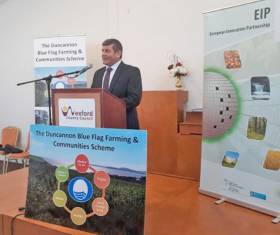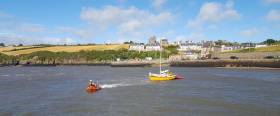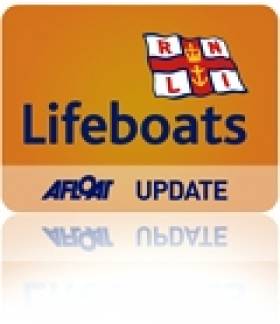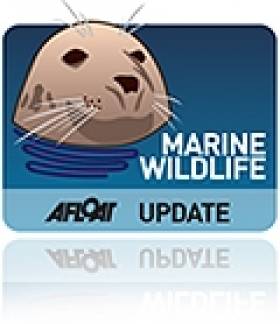Displaying items by tag: Duncannon
Duncannon Beach ‘Blue Flag’ Scheme Launches In Wexford
#CoastalNotes - A new locally led scheme for the recovery and long-term retention of Duncannon Beach’s Blue Flag status has been launched in Co Wexford.
The Duncannon Blue Flag Farming and Communities Scheme is a European Innovation Project (EIP) funded by the Department of Agriculture, Food and the Marine that will deal with pollution from both agricultural and domestic sources.
The project is one of 23 EIPs or locally led schemes funded by the department under the current Rural Development Programme.
The Duncannon Blue Flag Farming and Communities Scheme has been allocated €550,000 to improve the bacterial quality of the two coastal streams that flow onto Duncannon Beach, which has steadily improved its bathing water quality from ‘sufficient’ in 2016 to ‘good’ in 2017 in the EPA’s most recent Bathing Water Quality in Ireland report.
The scheme applies the Water Framework Directive principles of Integrated Catchment Management whereby a range of pollution sources are considered in unison for multiple benefits in an integrated, holistic manner.
Speaking at the launch, Andrew Doyle, Minister of State at the Department of Agriculture, Food and the Marine, said: “One of the objectives of this scheme is to generate a greater sense of local ownership, responsibility and appreciation for the local water environment in the Duncannon area.
“Its implementation will, through the co-operation of all local stakeholders, ultimately bring about improved water quality and a better environment in this area.”
The operational group for the project is representative of a number of stakeholders and is led by Wexford County Council. It also includes personnel from Teagasc, local agricultural consultants, Glanbia, Bord Bia, the local farming community and the IFA.
“This is exactly the type of scheme that was envisaged when my department chose to drive the EIP initiative under the current Rural Development Programme,” said Minister Doyle. “It complements extremely well the many other water quality improvement projects which my department is supporting.
“As with all EIP projects, the knowledge from this project will be shared, through the EIP network, with similar communities throughout Ireland and will help to improve water quality in other sensitive catchments areas.”
A total of €59 million is being made available for EIP projects by the Department of Agriculture, Food and the Marine. €24m of this is allocated to smaller EIP projects chosen by a competitive Open Call process. Another €35m is available for the hen harrier and freshwater pearl mussel projects.
Fethard RNLI Rescues Two People After Yacht Runs Aground off Wexford Coast
Fethard RNLI rescued two people after their yacht ran aground off the Wexford coast yesterday evening.
The volunteer lifeboat crew was requested to launch their inshore lifeboat shortly after 5pm following a report from the Irish Coast Guard that a vessel with two people onboard had got into difficulty.
The 27ft yacht had run aground on a mudbank in Duncannon Harbour.
The lifeboat launched at 5.27pm and was on scene at 5.30pm. Dunmore East RNLI’s all-weather lifeboat was also launched.
Weather conditions at the time were good with a south west Force 5 wind and moderate seas.
Having assessed that the two people onboard were safe and well, the lifeboat crew proceeded to work with them to establish a tow line at the back of the yacht. However, this set up proved challenging and it was decided to tow the vessel from the front.
The yacht was successfully re-floated by Fethard’s lifeboat while Dunmore East’s all-weather lifeboat stood by in the event more power was required.
The yacht then safely continued on her own to Dunmore East.
Speaking following the call out, Hugh Burke, Fethard RNLI Deputy Launching Authority said: ‘As we continue to enjoy the summer, we would remind anyone planning a trip at sea to go prepared and respect the water. Communications is vital and it is important that you always carry a means of calling or signalling for help should you get into difficulty and need to contact the emergency services. If you do find yourself in trouble or see someone else in difficulty call 999 or 112 and ask for the Coast Guard.’
Fethard RNLI Launch Lifeboat to Kite Surfer off Duncannon Beach
Lifeboat crew with Fethard RNLI in Wexford launched yesterday afternoon to assist a kite surfer who had got into difficulty off Duncannon beach in Wexford. The alarm was raised shortly after 2pm when the man could not safely return to shore and was in danger of drifting out to sea.
Fethard RNLI operates an inshore lifeboat which can be launched from multiple locations by Land Rover. For this callout the lifeboat crew travelled from the station to Duncannon and launched to reach the casualty as quickly as possible.
Deputy Launching Authority Hugh Burke also travelled to the location to spot the kite surfer from the beach and keep in contact with the Coast Guard. The casualty was sighted a kilometre away from the beach where he had rolled up his lines and folded the kite down, using it as a sail to guide him inland.
The kite surfer was blown onto shore at Glen Bay, a short distance away and was awaiting help. However with high cliffs making communication with the lifeboat difficult and an obstructed view with the casualty’s clothing blending into the background it was impossible to guide the lifeboat to his exact location. The casualty worried that he had been missed by the lifeboat and the Coast Guard helicopter, which was also on scene and started to make his way inland through fields, leaving his gear behind him on the beach.
The lifeboat crew came upon his equipment a short time later, immediately recovered it on board and continued to search, unaware that the casualty had continued on foot overland.
Fearing the worst Hugh and the two members of the RNLI shore crew took the RNLI launching vehicle and proceeded to the spot where they had observed the man being blown in, to see if they could locate him. A short time later they met him making his way back to Duncannon over land. He was immediately taken into the vehicle where he showed no signs of injury and was brought to be reunited with his relieved family at Duncannon pier.
Commenting on the callout Fethard RNLI Deputy Launching Authority Hugh Burke said, ‘It wasn’t your usual type of callout for the lifeboat crew. I think it was the first time the launching vehicle and not the lifeboat brought someone to safety. However we are delighted that the man was found safe and sound. The lifeboat crew feared the worst when they came across his equipment and found no sign of him.
He did the right thing when he realised he was in trouble and made sure he folded up his gear so that he wouldn’t be blown out to sea and tried to steer inland. Conditions were not great with rain, low cloud and a south-easterly wind of force three to four so we are relived it had a good outcome.’
Lifeboat crew on the callout were Helm Rory O’Connor with Cathal O’Connell and Nicolette Perrella and Shore Crew Mark Brenna and Jack Butler
Duncannon Pier Pontoon. Berths for Boats in County Wexford
Duncannon Pier Pontoon is at Waterford Harbour’s eastern shore, six miles north of Hook Head lighthouse. It is a small fishing port where you may come alongside the commercial wall. In 2010, following the provision of €56,250 to improve boat access on piers along the Hook Peninsula such as Ballyhack, Slade and Arthurstown Wexford County Council installed a small pontoon facility to encourage leisure boating in the area. As well as local boaters the faciility is also proving popular with local fishermen.
Lifeboat Roundup: Windsurfers Rescued In Waterford; Boats Aground in Wexford, Lough Erne
#RNLI - The Dunmore East RNLI lifeboat was tasked yesterday (7 April) to assist two windsurfers in difficulty near Duncannon in Waterford Harbour.
In rough conditions yesterday afternoon, with south-east winds force 6/7 blowing, coxswain Pauly Daniels reached the casualties' position within 30 minutes.
By this stage one of the surfers had made it ashore safely at Duncannon. The Dunmore East lifeboat quickly located the other windsurfer a quarter of a mile north of Duncannon. The casualty was safely recovered from the water and landed ashore nearby.
Neither casualty was injured and did not need medical attention.
Nearby in Wexford, five teenagers were rescued from a small speedboat after it suffered engine failure and ran aground on the River Slaney around 1.20pm yesterday.
According to Lorraine Galvin, volunteer press officer at Wexford RNLI, the teens' "fast call for help to the coastguard greatly helped in ensuring their speedy rescue in cold, rough weather conditions".
At the time of the rescue there were wind speeds of force 5 south-easterly and a rough sea state. All of the passengers were starting to suffer from the cold and were treated for mild hypothermia.
Meanwhile, on Upper Lough Erne last Friday the volunteer lifeboat at Enniskillen RNLI (Carrybridge) launched to reports of a vessel that had run aground.
The RNLI lifeboat and rescue water craft were both launched and proceeded to the casualty's last known location 2.5 miles upstream from Carrybridge at Innishmore viaduct.
On route to the scene at the Innishmore viaduct, the volunteer crew got further information that the vessel had managed to refloat and was currently at Killygowan Island.
A full inspection was carried out and none of the crew on the casualty vessel were found to be in need of medical attention.
It was decided with the owner's permission that the volunteer crew would escort their vessel back to Carrybridge with the lifeboat leading and rescue water craft following as the navigation lights were not working.
More Dead Seals Wash Up On Wexford Beach
#MarineWildlife - The Gorey Guardian reports that three seal carcasses were found washed up on Duncannon beach in Co Wexford this past Tuesday (22 January).
The National Parks and Wildlife Service is presently awaiting lab results to determine the seals' cause of death, a situation conservation ranger Tony Murray describes as "quite unusual".
He added that the carcasses of the three marine mammals were freshly dead and found to have no external injuries
As previously reported on Afloat.ie, the Irish Seal Sanctuary last month called for immediate action after a total of 12 seal carcasses were found dead on beaches in Wexford and Waterford in the span of a single week.
Irish Kitesurfing Nationals in Wexford This Weekend
#KITESURFING - The annual Wexford Kite Surfing Festival on Duncannon Beach will once again play host to the Irish National Kite Surfing Championships this weekend 25-26 August.
Presented by the Irish Kitesurfing Association (ISKA) and Wexford-based start-up school Hooked Kitesurfing, the two-day content will present the best in junior, men's and women's kitesurfing in course racing and freestyle events.
As organiser Niall Roche tells Visit Wexford, the global field of competitors will for the first time be reflected with an international judging panel.
"It’s a real boost for the festival and indeed for kitesurfing in Ireland," he says. "This event will be the biggest kitesurfing event on the national calendar this year, we are expecting over 50 kitesurfers to compete."
And aside from the action on the water, the festival weekend includes fun for all the family from water zorbing to archery, face painting, power kite lessons for kids and a beach party with barbecue. Details of events and competition times are available HERE.
MCIB Again Cites Lack of Lifejackets in Na Buachaillí Capsize Death
#MCIB - Marine investigators have again highlighted the lack of lifejackets as contributing to loss of life in the official report into the capsizing of a fishing vessel off Co Wexford last year.
Crewman John Ennis was lost when the two-man vessel Na Buachaillí capsized and sank close to the shore in Waterford Estuary near Duncannon on 18 February 2011.
Skipper and owner Richard McNamara survived the incident. More than a month later, Ennis's body was recovered from the water on 21 March 2011. Neither man had been wearing a lifejacket despite all requisite safety equipment being available.
According to the report from the Marine Casualty Investigation Board (MCIB), the boat had been dredging for mussels in the estuary – using a custom gantry installed at the stern – when McNamara steered to port to make way for a merchant ship and the Waterford pilot boat which were coming down river.
Using a motorised winch, McNamara hoisted the dredge to which Ennis attempted to attach the line when the vessel began to list to starboard. The skipper returned to the winch controls but was unable to drop the dredge. He saw that Ennis was holding onto the dredge gantry, bracing himself against the list.
McNamara then tried to enter the wheelhouse to activate the EPIRB emergency beacon but the boat was now listing rapidly and he was forced by a rush of seawater into an area forward of the engine under the forward deck.
By a quirk of fate the water flow suddenly reversed and McNamara was thrown out of the wheelhouse, and he just managed to grab gold of a lifering mounted on the wheelhouse roof before swomming to shore to raise the alarm.
The vessel was later recovered by Naval divers who found no damage to the hull nor any evidence that the dredge or any other part of the boat has been snagged by something in the water.
Based on the evidence gathered by investigators, the most likely reason for the capsize was the result of instability resulting from the vessels position between the onshore wind and the outgoing tide, exacerbated by the vessel's higher than recommended breadth-to-depth ratio.
The listing was compounded by the boat's interconnected fuel tanks, while the distribution of the mussel catch on deck and the apparent starboard lean of the suspended dredge may have also played a role.
Echoing its recent reports into the drowning of three men on a fishing trip of West Cork in August 2010, as well as the loss of two lobstermen off Skerries in April 2011, the MCIB recommends that lifejackets be worn at all times while on a vessel.
It also notes that emergency beacons should be mounted outside the wheelhouse for better accessibility and preferably be of the automatic free-float type.
Additionally, the MCIB has called for proper authorisation of physical alteratuons to small fishing vessels that may affect stability, and recommends revisions of the Department of Transport, Tourism and Sport's (DTTAS) Code of Practice for such vessels under 15m in length with reference to stability, EPIRBs and life rafts.
The full report is available to download as a PDF from the MCIB website HERE.
Dolphin Rescued in Co Wexford
#MARINE WILDLIFE - A stranded dolphin was rescued at Duncannon on Monday last week, the New Ross Standard reports.
After being spotted by a member of Fethard-on-Sea RNLI, the dolphin was aided by the lifeboat crew, with advice from the Irish Whale and Dolphin Group.
The juvenile dolphin, who appeared to show no distress from the incident, was taken out to see and released in deep water off Templetown strand.
A spokesperson for Fethard-on-Sea RNLI said the crew were "'especially pleased to have undertaken such a rescue mission with a successful outcome".
Container Ship Successfully Refloated in Waterford Harbour
In attendance was Bargarth, a UK-flagged tug based in Waterford and operated by Fastnet Shipping. The twin Voith & fire-fighting tug made a special appearance during the Tall Ships Races Parade of Sail on 3 July, when she put on a celebratory water-display off Dunmore East.
Samskip Eandeavour is capable of handling 812 twenty-foot equivalent containers (TEU). She was completed only this year by Damen Gorinchem Scheepswerf B.V. Foxtol in the Netherlands. The vessel is operated by an Icelandic company, Samskip which provides several container feeder-liner services between Rotterdam / Zeebrugge with Belfast, Dublin, Cork and Waterford.
After unloading and loading at Belview the 140m vessel is scheduled to dock in the Port of Cork tomorrow at the Tivoli Container Terminal before returning to Europe.


























